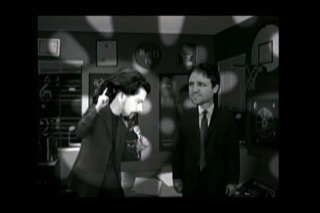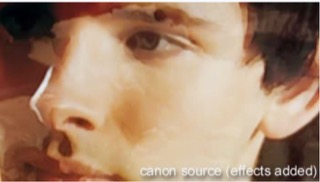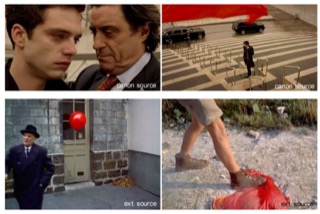On External Source
This meta was first posted on Livejournal in the Vid Commentary community in 2010. It’s such an interesting examination of this subject I’ve seen, and only gets more so as time passes and vidding moves on. I’ve always admired this piece, and the vidder who wrote it, Obsessive24. (Her vids are not always so easy to come across but I advise you to do, and start here!) Her vid, The Lightning Strike was recently shown in the exhibition Mashup, the Birth of Modern Culture at Vancouver Art Gallery. That vid, made two years after this piece was written, integrates source from multiple fandoms and historical imagery.
I’ve remade a lot of the stills at a larger size etc. Some of the vids linked in this piece are not around online any more, and few are embeddable. But where vids can be linked I’ve done so, and I’ve embedded a few where pos.
~lim
I’ve been asked to write something about external source. In truth, my thought processes usually start and end at “Whee! Pretty!” and not much besides, but I gave it a try, it’s just my take on the matter, and I hope it can be a jumping-off point for discussion and thinkies from people far more articulate than me.
To clarify: the focus here is on “vidding with external source”, not “vidding with multiple sources”. It’s about vids that have a primary narrative based in one singular source or canon, despite using some additional source from other areas to supplement the execution. It does not cover, for example, using multiple sources and blending several different canons into one vid - I feel that’s a largely separate topic that perhaps someone else would care to discuss later.
TL;DR: Key takeaways
- “Show, don’t tell.” External footage is useful when canon footage is not sufficient for me to express an idea visually.
- Viewers can interpret a vid differently to my intention. External source can help clarify my intention, particularly for AU/constructed reality.
- External source supplements the vid’s narrative: it can be used as though it were actual canon footage, or used in a more abstract way for mood and metaphor.
- Planning is important: external source should feel integrated into the vid’s visual style, not tacked-on as an afterthought.
- Some things to consider when integrating external source: colour, lighting, clip quality, framing devices, timing and consistency of use.
- Only a means to an end: too much external source can stifle the primary narrative.
For me, it's always been about necessity
The why
I don’t ever recall an occasion where I knew I could make the vid I wanted using available canon footage, but decided to use external source anyway. For me, it’s always been about necessity, where I simply can’t say what I need to say in the vid by using canon footage alone.
“Necessity” can include a lot of things, such as:
- Inside canon
- Canon’s actual scope versus canon’s scope as presented in source
- Showing canon’s intended ties to other canons
- Showing canon’s intended ties to real world events
- Outside canon
- Creating AU narratives
- Vidding outside of the canon fiction
Of course vidding is a far more organic process than a numbered list. If you use external source, chances are that you use it for a combination of the above factors. The same goes for pretty much all of the examples used here.
2. Outside canon
For anyone who ever said anything offhand or well-intentioned but only to have it taken completely the wrong way, you can see how disambiguation can be important even when we have full mastery of our language. It can be even more difficult to try and “speak” through images alone. Sometimes you might need the audience to understand what you’re saying without any ambiguity. In those cases, external source taken at face value can help clarify the story the vidder intends to tell.
For AU or meta narratives, external footage can allow me to make my point rather than simply allude to it. This can be important because viewers can bring a varied range of reading levels to vids. If something is inferred rather than explicitly spelt out in terms of visuals, it may be immediately obvious to viewer A, while at the same time completely not register with viewer B.
2.1. Creating AU narratives inside the canon fiction
A classic example for slash fans: two male characters glower intensely at each other. I infer that they need to have hot angry sex right now. Yet, surprisingly to me, my husband senses no sexual tension whatsoever.
It’s an extreme example, but what if your vid suggests angry sex through such clips, but viewer B is sitting there blankly, asking “there was supposed to be angry sex in there?” If actual angry sex is necessary for the vid’s overall narrative to make sense, then it would be useful for the vid to show the angry sex instead of merely inferring it, so that most (if not all) viewers can follow the vid’s intended narrative.
I think T. Jonesy and Killa’s Closer paved the way of a host of slash vids using external sex scenes. A more recent offshoot of this is the emergence of constructed images, e.g. in gigglemonster’s The Scars of All I’ve Known, which uses a range of constructed Sam/Dean love scenes.

Of course external source for AU narratives is not restricted to sex scenes. An often-seen example is using footage of the same actor from another source as though it were canon source for the vid.
I think external/constructed footage has significantly freed up the kinds of stories that vidders can tell, because we’re no longer restricted to interpreting or subverting only that which is given to us in the canon source. To some extent, it lessens the distance between “what I intended for the audience to see” vs. “what the audience actually saw”.
2.2. Vidding outside of the canon fiction
Or what I define as “meta-commentary”. As an abstract concept, “meta” may mean different things to different people. For the purposes here, I will define it as “commenting on how we interact with a work, rather than commenting on the work itself.”
Firefly fandom is well-known for its loyal fan base. bradcpu and laurashapiro’s Hard Sun intercuts fan-filmed clips of real fans around the world to demonstrate how the show remains in our hearts and minds. As a vid, it’s not so much about the fictional stories within Firefly as it is about our reactions to those stories and, beyond that, our reactions to real-world events relating to the show, such as its cancellation, or even about our fannish processes, such as the process of visualising a vid in our real-world travels. It’s meta that focuses on fannish love, and the external source is crucial for carrying the concept of real fans out in the real world.
Contrast with jarrow’s Tandemonium, which is critical meta-commentary. The vid uses external “behind the scenes” footage and quotes of show runner Ron D. Moore, intercut with actual clips from BSG, to examine how and why the vidder thought how the writing and characterisations of BSG went wrong in the endgame. Again, this is not so much a vid about the canon fiction than it is about our reactions to it. The external source, while not significant in terms of the number of clips, is extremely important because the Moore person/concept only exists outside of the canon fiction and so can only be shown with external source.*


The other significant external input in Tandemonium is the use of text. It starts by quoting Moore verbatim, but progresses into pinpointing fallacies and inconsistencies in these quotes, and ends with a direct textual accusation that is made from the perspective of the vidder/critical fan. Not necessarily external “source” per se, but its use is comparable to the use of external source - it clarifies the vidder’s intentions and makes it that much easier to understand an argument that must be otherwise articulated by visuals and lyrics alone.
- Incidentally, the distinction between what is inside and outside of the fiction probably also drove the fan consternation when Moore appeared in a cameo in the final scene to BSG, which can be seen as an awkward way to shoehorn himself into the canon fiction for no good reason.
The how
- Sourcing and concept
- 3.1. Examples of where to look
- 3.2. Using external source as metaphor
- Integrating external source into a vid
- 4.1. Easing the audience into it
- 4.2. Seamless integration vs. deliberate contrast
- 4.3. How much is too much?
3. Sourcing and concept
If you are thinking of using external source, chances are that you already have an idea of what you want to use and where to look. So I will cover that only briefly with some examples in [3.1].
However, there are times when I know my canon source is inadequate and that I’m going to need some assistance from external source, but I don’t know what kind of external source I could use to fatten up the vid in a coherent way. In those cases, lateral thinking may help by bringing in external source as a key metaphor, discussed at [3.2].
3.1. Examples of where to look
News and documentaries.
Nature documentaries in newkidfan’s Surrender to enhance mood.


Historical documentaries and news items in rhoboat’s Right in Two to tie the vid’s narrative to the wider world context, as discussed in [1.3].
Professional music videos.
For example, footage from Christina Aguilera’s Fighter in milly’s In My Veins for mood and metaphor. Footage from Marilyn Manson’s Dope Hat in Candyman to create an AU interpretation/meta-commentary.
Old/distinctive-looking movies/shows.
3.2 Using external source as metaphor
Personally, I don’t use external source unless I have to. A lot of the time it happens when I’m trying to vid a secondary character or relationship which doesn’t get much screen time, to the extent that I can’t make an eloquent or nice-looking vid with the source footage that I have. In those cases I try to think laterally and bring in external source as a metaphor.
“Thematic metaphor” and “character-oriented metaphor” are just a couple that came to mind. Doubtlessly there are many others. For me, this kind of thought process tends to connect through abstract concepts, and mostly it seems like random inspiration. As a very broad take-away I would suggest keeping in mind that external source metaphors may be less about strictly visual parallels, and more about the broader feeling that the vid tries to convey.
3.2.1. Thematic metaphor

Personal example: I’m planning a Kings vid about a canon gay character (a prince) who’s forced to stay in the closet for political reasons, primarily driven by his father the king. While a decent amount of dialogue is devoted to the topic, there’s less in the way of visuals that convey this idea succinctly and powerfully that can be used in the vid. Even though viewers with context will know intellectually what is going on, I still felt that I needed to bring in external source to make the vid visually and emotionally robust.
To convey the message I want, I’m going to use footage from an old French film The Red Balloon, about a young boy who befriends a red balloon, which follows him around. However, the school master locks up the boy so that he’s separated from the balloon, and later, some other boys throw rocks at the balloon and deflate it. What drew me to this metaphor was the themes of forced separation, intolerance and careless cruelty, together with the significance of the colour red to GLBTQ causes in general. You can also see in the screencaps how the external source will reinforce the use of red in canon source.
3.2.2. Character-oriented metaphor
I’m very partial to character-as-animal metaphors because I think that gives amazing capacity for emotional connection. I’ve never been able to figure out exactly why, but time and time again I feel myself punched in the gut by a good animal metaphor in vids, so it’s become something of a go-to for me.
Examples of character-as-animal metaphor using external source:


(Of course, you don’t necessarily need external source to make such metaphors. There’s often plenty of ammunition in source alone. Examples: wistful_fever’s Me, I’m a Thief, Darien as lab rat; aycheb’s Safe from Harm, Baltar as snake.)
Wow! that is amazing & audacious
4. Integrating external source into a vid
Sometimes external source in a vid makes me go “wow, that is amazing and audacious”, and sometimes it throws me out of the vid entirely. I think the difference lies in how well the external source has been integrated into the vid: whether the vid has an overall coherent feel, rather than coming across as having something random tacked on as an afterthought. For this reason I think it’s especially important to plan vids with external source.
4.1. Easing the audience into it
The average viewer of a fandom vid probably doesn’t expect to see external source unless you expressly warn them about it beforehand. You can of course warn outside of the vid, e.g. in vid notes, but in this context I specifically mean some sort of visual cue within the vid itself to let the audience know what’s coming.
I haven’t got any tricks for this: all that I try to do is to start using external footage early so that the audience can see it coming straight away, and adjust their expectations of the vid accordingly. It’s that word “expectation” that I think is the crux here - it would be very tricky to suddenly introduce external footage late in the game, because the viewer would have already built up an expectation of what they think the vid will be, and the introduction of external source often undercuts that expectation in a negative way**. Generally, the longer before the audience sees external footage, the more jarring I think it’s going to be for them. As a ballpark figure I personally like to introduce external source within 15 seconds of opening, as well as somehow alluding to it in the vid titles.
** Unless, of course, I’m very very clever and somehow manage to subvert that undercutting-of-expectation in a way that I had planned. But that’s more of an academic point - I certainly haven’t done it myself, and I can’t think of any vid off the top of my head that has done this with external footage. Maybe a challenge to somebody out there.
4.2. Seamless integration vs. deliberate contrast
How to incorporate external footage in a way that looks well-planned and integrated? To me, the key is to be committed and consistent. If you’re going for seamless integration, then really push for it by giving the vid a strong visual personality that would dominate over any differences between source and external source. If that can’t be achieved, then maybe think about going to the opposite extreme - really sell your intention of making the external footage a stand-out foreign aspect.
In contrast, what really doesn’t work for me is when the vidder doesn’t seem committed one way or another - the external source pops because of differences in colour, lighting, aspect ratio etc, but in a way that seems simply lazy rather than intentional.
4.2.1. Examples of seamless integration:

Carnival of Rust by absrip, using strong colour manipulation and constructed visuals to integrate. In particular, you can see how the uniform gold/rust palette got rid of any visual differences between sources that might have been otherwise jarring.

La Maree Haute by buffyann, introducing a strong water metaphor straight away, and maintaining it consistently throughout the vid. (Also note the link between visuals and lyrics - vid title translates to “high tide”.)

Living Dead Girl by bradcpu, using a specific TV/horror movie framing device to begin, and continuing to use that framing device throughout to create a strong, coherent visual identity.
4.2.2. Examples of deliberate contrast:
This kind of approach can work well for older footage, especially when you’re trying to integrate between colour source footage and external black and white footage, e.g. WWI and WWII scenes in respectively Marble House and Jesus for the Jugular, mentioned above. Other than colour, it also takes into account the differences in film quality.

An example of deliberate contrast in film quality: Piece of Me, contrasting pixellated YouTube footage against HD music video footage as comment on reality vs. media machine. (A bit cheeky because I don’t think that was “external source” per se in the context of the vid, but I ran out of examples.)

I also used deliberate contrast in Mama by using two other versions of Hamlet to supplement the primary source of the RSC 2009 production. They are differentiated by colouring and framing.
4.3. How much is too much?
I couldn't get enough of outside source with this one. I did manage to cut myself off when I felt I was distancing the audience from the heart of the story, but you never know how well that works until you get your reaction from the public." - wistful_fever, on the making of Elemental.
My own vids have a tendency to come off cold because, among other things, I suspect I tend to over-use external source at times. So to me the question of “how much is too much?” is centred around whether the amount of external footage is undercutting the emotional flow of the vid and the subject matter, and I love how wistful_fever phrased it above. Sometimes external source is all about the pretty, and I need to keep reminding myself that external source is a means to achieving an end, not the end in itself.
Practical solutions: A good beta will hopefully tell you if your external source has choked your vid to death. Any other suggestions?
(Note: You can read the comments on this piece on the original posting on Livejournal.)





















